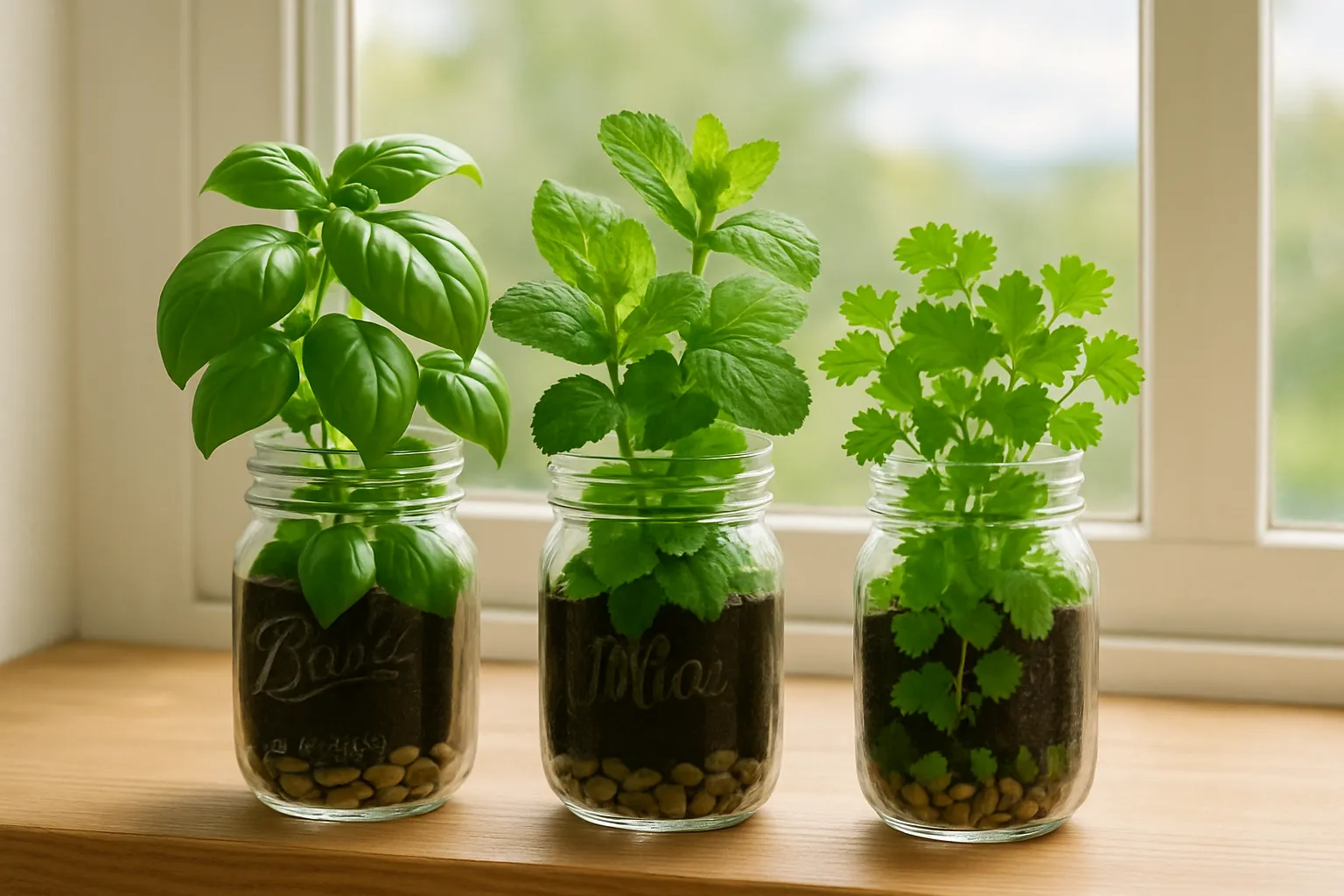Sustainable living doesn’t have to be complicated or expensive. This article presents a collection of simple DIY projects that can make a significant impact on reducing your environmental footprint. Drawing from the expertise of community members and sustainability professionals, these practical tips offer accessible ways for anyone to contribute to a greener future.
- Eco-Friendly Paint Recycling Cuts Waste
- Smart Irrigation Saves Water and Plants
- Water Butt Conserves During Drought
- Vertical Herb Garden Inspires Micro-Gardening
- DIY Natural Cleaners Reduce Environmental Impact
- Backyard Composting Diverts Organic Waste
- Preserved Flowers Create Long-Lasting Sustainable Decor
- Weather Stripping Improves Energy Efficiency
- Drying Rack Slashes Energy Bills
- Coffee Station Turns Grounds Into Fertilizer
- Homemade Compost Bin Reduces Organic Waste
- Off-Peak Backups Lower Carbon Footprint
- Native Plants Promote Local Biodiversity
- Antique Basins Harvest Rainwater Stylishly
- Window Sealing Boosts Home Energy Efficiency
- Home Vegetable Garden Reduces Food Miles
- T-Shirt Cleaning Cloths Cut Paper Waste
- Pet Waste Compost Bin Minimizes Landfill
Eco-Friendly Paint Recycling Cuts Waste
I switched all my painting projects to low-VOC and eco-friendly paints about five years ago after seeing too many clients complain about headaches and indoor air quality. What started as a customer service move has cut my material waste by approximately 30% since these paints have better coverage and durability.
The real game-changer was implementing a paint recycling system in my shop. I collect leftover paint from jobs and mix custom colors for smaller touch-up projects instead of buying new. This saves me about $200 monthly in material costs and keeps approximately 15-20 gallons of paint from reaching landfills each month.
I also started reusing drop cloths and investing in quality brushes that last years instead of cheap disposables. My equipment costs dropped significantly, and I’m not throwing away plastic sheeting after every job. The durability factor means my clients need repaints less frequently too — I’ve had exterior jobs last 8-10 years instead of the typical 5-6.
The sustainability angle has become a major selling point with younger homeowners in Springfield. About 40% of my new clients specifically ask about eco-friendly options now, and they’re willing to pay slightly more for it.
 Jame M. Cleaver
Jame M. Cleaver
Owner, Springfield Paint Pros
Smart Irrigation Saves Water and Plants
After nearly two decades in construction and landscaping, I switched to smart irrigation timer systems for my own property and started recommending them to clients. The automated scheduling eliminates overwatering and targets specific zones at optimal times, typically reducing water usage by 30-40% compared to manual sprinkler management.
What surprised me was the compound effect — healthier plants with precise watering meant less replanting and fertilizer needs. My water bill dropped from around $120 monthly during summer to about $75, and I’ve had zero plant replacements in two years versus the usual 3-4 seasonal replacements I used to do.
The timing aspect is huge for sustainability — watering at dawn reduces evaporation loss significantly compared to afternoon watering. In California’s drought conditions, every drop counts, and I’ve seen clients save thousands of gallons annually just by automating their schedules properly.
The best part is it’s genuinely DIY-friendly if you have basic plumbing skills. Most timer systems connect to existing sprinkler setups, and the water savings pay for the initial investment within 6-8 months in our climate.
 David Shellu
David Shellu
Owner, Cascading Falls Inc.
Water Butt Conserves During Drought
I installed a water butt in my garden last year to help reduce my water consumption and save money.
Our area has recently had a drought declared, so we aren’t permitted to use hosepipes at the moment. The fact that I have access to fresh water in my water butt has saved my garden during the hot, dry months.
This also had the added benefit of ensuring my vegetable patch was watered with fresh rainwater, rather than over-processed tap water. I believe this, in turn, helped my crops thrive.
I’m planning on building myself a compost bin in the fall, so I’ll be turning my food and garden waste into fresh compost, ready for spring. Here’s hoping for an even better yield next year. The goal is that by growing my own vegetables, I’ll help reduce my environmental impact by using less fuel visiting stores, buy fewer processed foods, and save money into the bargain.
 Tina Bailey
Tina Bailey
Owner, MotherGeek
Vertical Herb Garden Inspires Micro-Gardening
I repurposed unused fencing wire and aged willow into vertical planters for herbs and edible flowers near our kitchen. The system hangs along a sunlit wall and requires minimal soil or watering, making it beautifully efficient. It grows rosemary, thyme, marigold, and calendula for both our meals and skincare rituals. That daily proximity to what we grow rekindled a deeper gratitude and attentiveness to seasonal cycles.
The project reshaped how we engage with food and beauty ingredients, rooting them firmly in everyday interaction. It also inspired guests to create micro-gardens, especially those with limited space or urban homes. The planter stands not just as a source of nourishment but as a symbol of connection. We do not need acres to feel the joy and wisdom of growing something by hand.
 Lord Robert Newborough
Lord Robert Newborough
Owner, Rhug Organic Farm & Rhug Ltd
DIY Natural Cleaners Reduce Environmental Impact
One of the most impactful changes I’ve made to live more sustainably is replacing commercial cleaning products with my own DIY solutions made from simple, natural ingredients like vinegar, baking soda, and lemon juice. This shift has transformed my cleaning routine into an eco-friendly practice that cuts waste, limits chemical exposure, and supports sustainable living, all without sacrificing effectiveness.
The environmental benefits start with waste reduction. Most commercial cleaners come in single-use plastic bottles that end up in landfills. By making my own solutions, I repurpose the same spray bottles and jars over and over, eliminating a steady stream of plastic waste. The ingredients themselves are low waste too, common pantry staples that don’t require layers of packaging or the complex supply chains associated with mass-produced cleaners.
There’s also a huge health advantage. Many commercial products contain volatile organic compounds (VOCs) and other chemicals that can irritate the respiratory system, contribute to indoor air pollution, and leave behind residues you’d rather not have on your counters or floors. My DIY cleaners avoid all of that. Vinegar, baking soda, and lemon juice are biodegradable, non-toxic, and safe for most surfaces. Plus, they smell fresh and natural without artificial fragrances.
The environmental impact goes beyond what’s inside the bottle. Harsh chemicals from traditional cleaners can enter waterways through runoff, harming aquatic life and disrupting ecosystems. My DIY formulas break down naturally, leaving nothing harmful behind. I also combine them with reusable cloths instead of disposable paper towels, which cuts down on paper waste and conserves resources.
Even ingredient sourcing becomes part of the sustainability equation. I can buy vinegar, baking soda, and lemons from local suppliers or farmers’ markets, supporting local economies while minimizing the environmental cost of long-distance shipping. Over time, this small act becomes a consistent, meaningful contribution to a more sustainable lifestyle.
What’s remarkable is how accessible this shift is. It requires no special tools, no complicated recipes, and no expensive “green” products, just a willingness to rethink what’s under your sink. It’s proof that sustainable living doesn’t have to be complex or costly; it can start with a few simple swaps that create a cleaner home and a healthier planet.
 Tyler Butler
Tyler Butler
Founder, Collaboration for Good
Backyard Composting Diverts Organic Waste
One simple DIY project I’ve implemented to live more sustainably — and one that I often encourage others in our industry and communities to consider — is building a backyard composting system using repurposed materials.
We emphasize the importance of reducing organic waste before it ever reaches our transfer stations or landfills. This small-scale, at-home initiative directly aligns with our broader goal of diverting organics from the waste stream — especially in rapidly growing regions like Texas where landfill capacity is a pressing concern.
I repurposed untreated wooden pallets from old delivery shipments to build a three-bin compost system. This setup allows for easy rotation of compost materials and efficient decomposition. By composting food scraps, yard trimmings, and even paper towels, I’ve been able to reduce my household’s waste output by nearly 30%. That means fewer hauls to the landfill, less methane produced from anaerobic decomposition, and healthier soil for landscaping — without chemical fertilizers.
This project has also been a meaningful educational tool when engaging with local civic groups or municipalities. It demonstrates that sustainability starts at home and doesn’t require complex infrastructure — just intentional habits and simple tools. For any community or individual looking to reduce environmental impact, composting is a practical, low-cost, and high-impact starting point.
 John Gustafson
John Gustafson
Founder, President & CEO, Frontier Waste Solutions
Preserved Flowers Create Long-Lasting Sustainable Decor
In my journey toward a more sustainable lifestyle, one simple yet impactful DIY project I completed was creating a preserved flower arrangement for my living space.
I wanted something beautiful and natural to brighten my home, but I was conscious of the waste generated by fresh-cut flowers.
That is when I discovered preserved flowers. They are a sustainable, long-lasting alternative.
Using a mix of preserved roses, eucalyptus, and gypsophila, I designed a bouquet that now sits proudly on my coffee table.
It was a very simple process. I selected stems that complemented each other in texture and color, trimmed them to fit a ceramic vase, and arranged them just as I would with fresh flowers.
The difference is that preserved flowers and plants don’t require water or maintenance.
This DIY project has helped me reduce my environmental impact in several ways.
First, preserved flowers last for months or even years, without the need for water or light.
Unlike fresh bouquets that are discarded after a week, my arrangement has remained vibrant and beautiful, reducing both organic waste and the carbon footprint associated with constant flower transportation.
Secondly, it has encouraged me to think more intentionally about the items I bring into my home.
I now prioritize reusable or long-lasting materials in all my decorating choices.
This small shift has gradually changed my mindset, influencing everything from how I shop to how I dispose of items.
Sustainability doesn’t always require big gestures.
Sometimes, a simple DIY project, like a preserved flower arrangement, can be a powerful reminder that beauty and responsibility can go hand in hand.
 Kathleen Bernazano
Kathleen Bernazano
Founder, Vermont Flowers (EPZ) Ltd.
Weather Stripping Improves Energy Efficiency
Installing weather stripping on our garage door was one of the easiest and most useful projects I’ve done. It took under an hour, cost less than thirty bucks, and made a big difference in how much hot air stayed out. During summer, we measured up to a ten-degree difference in garage temperature. That means our AC doesn’t have to work so hard, and the rooms next to the garage stay cooler. It reduces the load on the system, and we’ve seen about a fifteen percent drop in energy usage over the summer months.
We do this upgrade for customers too, and they always mention how quiet and sealed everything feels afterward. Less dust comes in, fewer pests sneak through, and the whole space feels tighter. Small projects like this one are easy to put off but pay off all season. It’s the kind of change you forget about until the bill comes and you realize things are working a lot better.
 Craig Focht
Craig Focht
Cofounder & CEO, All Pro Door Repair
Drying Rack Slashes Energy Bills
I cut my power bill by 18% just by swapping out my dryer for a $14 collapsible drying rack. Seriously. That thing paid for itself in 3 weeks. I used to run the dryer three times a week for 60 minutes per load. Now I dry clothes outside for free, with no noise and no heat. Bonus: clothes last longer and my laundry room no longer feels like a sauna. I stack it behind a door when I’m done, and it takes up zero floor space.
It’s kind of crazy how many people overlook the simple stuff. You don’t need solar panels to start saving money and cutting energy use. Sometimes a few wood dowels and a breeze do the trick.
 Patrick Beltran
Patrick Beltran
Marketing Director, Ardoz Digital
Coffee Station Turns Grounds Into Fertilizer
We love coffee in our house. But how can we be more sustainable and still keep up with our fast-paced life with two young kids?
We created a cozy little coffee station in the corner of our kitchen with a French press, freshly roasted whole beans, and a large repurposed tin can to store used coffee grounds.
Oh, that smell in the morning. There’s nothing like grinding beans each morning to kickstart the day.
The best part?
The grounds don’t go to waste. We use them on our lawn as fertilizer, turning our morning ritual into a small act of sustainability.
 Hilary Schultz
Hilary Schultz
Real Estate Investment Professional and Realtor, Bright Bid Homes
Homemade Compost Bin Reduces Organic Waste
A basic DIY project that I implemented to become a more sustainable person was creating a compost bin out of an old plastic storage container. I drilled holes in it to allow air circulation and added food scraps and yard waste, then placed it in a sheltered corner of my backyard. This was a small but significant step towards reducing my organic waste deposited in landfills. Rather than disposing of vegetable peels, coffee grounds, and eggshells, I used them to make nutritious compost for my garden. This not only reduces the amount of garbage but also improves my soil quality and decreases the need for chemical fertilizers. It is a simple, inexpensive initiative that has helped make a substantial difference in my household’s impact on the environment.
 Lexi Brown
Lexi Brown
Product Manager
Off-Peak Backups Lower Carbon Footprint
I implemented a simple yet effective scheduling change for my remote backup processes that significantly reduced my environmental footprint.
I reprogrammed my backup schedules to run during off-peak hours instead of during regular business hours. Rather than uploading my laptop’s backup data to remote cloud servers during the workday when network traffic is heavy and electricity rates are highest, I shifted all my cloud backup operations to evening and overnight hours.
This simple timing adjustment delivers multiple sustainability benefits:
- Reduced Energy Consumption: Off-peak electricity often comes from cleaner energy sources and requires less strain on the grid infrastructure.
- Lower Carbon Footprint: By avoiding peak demand periods, I’m contributing to reduced need for “peaker” power plants, which are typically the most carbon-intensive.
- Improved Efficiency: Faster upload speeds during off-peak hours mean my equipment runs for shorter periods, consuming less total energy per backup operation.
Not only do my backups complete 3-4 times faster during off-peak hours, but I’m also using significantly less electricity per gigabyte transferred. As someone in the data recovery industry, I understand how critical reliable backups are — but this simple scheduling change proves you don’t have to sacrifice environmental responsibility for data security. It’s a win-win that any remote worker or business professional can implement immediately.
 Robert Chen
Robert Chen
VP & CIO, DataNumen
Native Plants Promote Local Biodiversity
Rethinking the landscaping around my home has been one straightforward DIY project I’ve undertaken in an effort to live more sustainably. I noticed a couple of years ago how much I was spending on water for numerous non-native plants in my landscaping, including a traditional grass lawn. I figured it also couldn’t be great for the environment to be using so much water to try and keep these plants alive. So, I’ve been tackling this project in stages, where I’m removing non-native plants and replacing them with native ones. I have also removed sections of my lawn to convert them into wildflower/pollinator gardens.
I do think this can make a huge difference in environmental impact, even just on a local level. I’m using less water and promoting local biodiversity, along with helping out the ecosystem by providing native plants for wildlife. The loss of bee populations has been particularly troubling to me, so it’s also nice to see them buzzing around the pollinator gardens.
 David Joles
David Joles
Chief Operating Officer, PURCOR Pest Solutions
Antique Basins Harvest Rainwater Stylishly
One of the most impactful DIY projects I’ve done was converting antique stone basins, once used in old European farms, into a rainwater harvesting system for our garden. It’s a sustainable twist on luxury that not only honors the past but actively reduces our municipal water use by nearly 40%.
Most people overlook the decorative potential of functional sustainability. But when you integrate reclaimed stone with native landscaping, you don’t just reduce waste; you create beauty with purpose. This isn’t about buying “green”; it’s about rethinking what already exists around us.
These stone vessels, originally discarded, now irrigate our outdoor living space and serve as a reminder that sustainability doesn’t always mean compromise; it often means craftsmanship and creativity.
 Erwin Gutenkunst
Erwin Gutenkunst
President and Owner, Neolithic Materials
Window Sealing Boosts Home Energy Efficiency
For me, caulking around and re-sealing windows has been one of the biggest DIY projects I have done around the house to live more sustainably. I like this as a sustainable living “hack” because it’s also going to make your home more comfortable and potentially save you some money on climate control. Many older windows can develop cracks and gaps around the frame, which lets in air from outside and can mean your HVAC system is working harder than it needs to, using energy and costing you money. By sealing these, you’re going to be using less energy toward heating or cooling your home, and therefore reducing your environmental footprint.
 Carr Lanphier
Carr Lanphier
CEO, Improovy
Home Vegetable Garden Reduces Food Miles
The top DIY project I have done to live more sustainably is to plant a vegetable garden myself. This is pretty simple once you’ve done a little research and planning! I had a great time with it and continue to have a great time growing my own produce at home. I’ve had success growing a pretty good variety of vegetables and herbs over the past few years.
For me, growing produce at home means buying less from stores, which could mean fewer emissions from trucks that haul produce all over the country and in from other parts of the world. My next plan is to build a home greenhouse so I can grow a bigger variety of produce throughout the year.
 Ryan Farley
Ryan Farley
CEO, LawnStarter
T-Shirt Cleaning Cloths Cut Paper Waste
One simple DIY project I completed was creating reusable cleaning cloths from old t-shirts. It reduced paper towel use and gave new life to clothes I would have otherwise discarded. It’s a small change, but over time it has reduced waste and saved money.
 Keagan Stapley
Keagan Stapley
Owner, NYC Meal Prep
Pet Waste Compost Bin Minimizes Landfill
One simple DIY project I’ve done as a veterinarian to live more sustainably is creating a pet waste compost bin. Instead of tossing pet waste in the trash where it ends up in landfills, I set up a dedicated compost system designed to safely break down biodegradable pet waste. This reduces landfill waste and helps recycle nutrients back into the soil in an eco-friendly way. It’s an easy, low-cost project that encourages responsible pet care while minimizing plastic bag use and harmful runoff.
 Kimberly Mordasky
Kimberly Mordasky
Owner, Veterinarian, Hebron Veterinary Hospital

